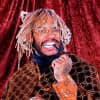Though it weirdly/smartly never addresses sexuality, Lil B's I'm Gay does position the Based God as maybe the greatest conscious rapper of our time. Look at this album cover, think about it. At first it seems not too-too weird, a triptych play on a 1970's painting by Los Angeleno Ernie Barnes. At second glance, it's way richer—evoking Barnes' interest in mannerism, the Black Romantic and narrative expressionism. See our breakdown of the influences on B's work of art, above, and read more about them, below.
Ernie Barnes' Sugar Shack, 1971
Sugar Shack debuted in 1971 at Barnes' LA solo show, called The Beauty of the Ghetto. In 1973, as the show toured the country, Barnes told The Atlanta Journal and Constitution, "I am providing a pictorial background for an understanding into the aesthetics of black America. It is not a plea to people to continue to live there but for those who feel trapped, it is… a challenge of how beautiful life can be."
Marvin Gaye's I Want You album cover, 1976
Marvin Gaye owned eight of Barnes original paintings, including Sugar Shack, and in 1976 he commissioned the artist to adapt the painting for his 13th album's cover.
Bob Marley, "Redemption Song", 1980
This was Bob Marley's last single before his death, with lyrics inspired by a 1937 speech by the Pan-Africanist Marcus Garvey. Paraphrasing Garvey, Marley sang Emancipate yourselves from mental slavery/ None but ourselves can free our minds.
Mannerism, 1520-1600
A visual arts movement in Europe between the High Renaissance and Baroque periods. Mannerist painters "emphasized complexity and virtuosity over naturalistic representation," distorted the human figure and flattened pictorial space.
Camp Lo's Uptown Saturday Night album cover, 1997
Camp Lo's debut album was a triumph of ’70s-referencing jazz-rap, featuring cover art inspired by Barnes' Sugar Shack and a record title referencing the 1974 film starring Sidney Poitier, Bill Cosby and Harry Belafonte.
Max Beckmann's Beginning, 1949
Beckmann, a German painter inspired by impressionism, made a lot of money selling paintings around Europe before he was 30. After WWI he moved to the US and his work changed dramatically. Beginning is a retrospective triptych, the eighth of ten autobiographical paintings he made at the end of his life. It was painted in New York. Beckmann is cited as a profound influence on American painter Phillip Guston.
Good Times, 1974-79
Sugar Shack was featured in the opening credits of the pioneering sitcom Good Times, which centered around a poor African American family living in a high rise project in Chicago.
Faith Ringgold's Street Story Quilt, 1985
Ringgold's 12-foot wide quilt depicts a Harlem street scene, an expressionist tribute to the story of A.J., a boy who "ran away from home right after big Al's funeral. He was picked up a few days later for sellin dope to a cop."
Barkley Hendricks
Barkley Hendricks is a contemporary American painter best known for his life-sized oil portraits. "He was depicting people who weren't seen to be important," says Trevor Schoonmaker, curator of contemporary art at The Nasher Museum of Art in North Carolina. "And it wasn't looking back, it was like right in the moment. He was right on the cusp of exactly what was happening at the time politically and socially, but he wasn't actively trying to be political in his engagement, he was just representative, but the way he painted people was so bold. Bold and blunt."
Ellen Degeneres' TIME magazine cover, 1997
DeGeneres "came out" on the cover of TIME, with the bold red headline, "Yep, I'm Gay."


